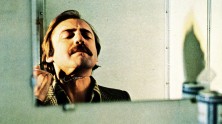
Tremors of Forgery: Filming Patricia Highsmith
Frequently, filmmakers talk about “getting away with it,” about those serendipities when they are able to make the movie they want to, despite the enormous pressures put on them by their producers, distributors, and audiences. No wonder, then, that so many of them—from Hitchcock and Melville to Wenders, Cavani, and Malkovich—are attracted to the writing of Patricia Highsmith, whose greatest character, Tom Ripley, gets away with far more, far more often, than even the most delusional auteur.
In this tightly focused series we look at two versions of two of Highsmith’s Ripley novels. Each initial film — Purple Noon or The American Friend — is less adaptation than reckoning: what is at stake in our fascination with the suave murderer? And each follow-up film — The Talented Mr. Ripley or Ripley’s Game — is less remake than restoration: can we push our sympathies even further? What might we lose?
Reckoning and restoration may evoke moral problems of suasion and imposture, but these moral problems are realized only through especially fine specifics: beautiful boats, pieces of wood becoming frames, colonnades in fading lakeshore light, and performances that suggest that we should all know what close cousins decency and horror really are. – J.D. Connor







